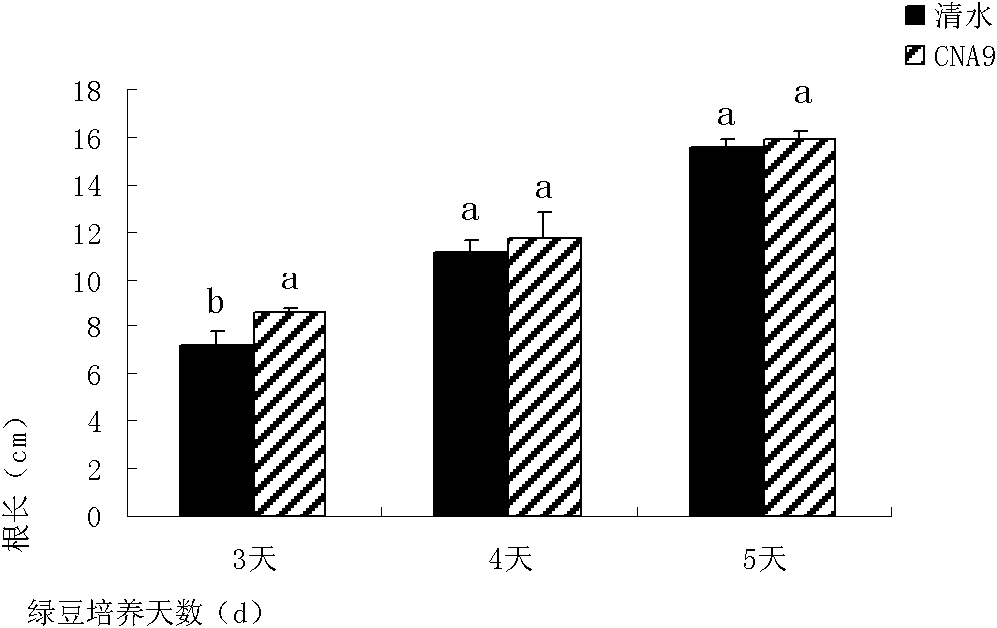Method of detecting growth promoting effect of plant rhizosphere growth promoting bacteria
A technology of rhizosphere growth-promoting bacteria and growth-promoting bacteria, which is applied in the direction of biochemical equipment and methods, and microbial measurement/inspection. The effect of reducing material cost and improving screening efficiency
- Summary
- Abstract
- Description
- Claims
- Application Information
AI Technical Summary
Problems solved by technology
Method used
Image
Examples
Embodiment 1
[0028] Embodiment 1 material and equipment
[0029] Plants to be tested: mung bean (Green Pearl, purchased from Shanxi Boda Seedling Co., Ltd.); corn (Nongda 108), which is commercially available.
[0030] Tested strains: CNA9 (Arthrobacter globiformis), CGMCC No.4217, MOB13 (Pseudomonas pseudoalcaligenes), CGMCC No.2763.
[0031] Test agent: 70% alcohol; Solution I: 10mM phosphoric acid; Solution II: 1mL0.5M FeCl 3 Dissolve in 50mL 35% HClO 4
[0032] Test medium: LB liquid medium: peptone 10.0g / L, yeast extract 5.0g / L, NaCl 10.0g / L, (agar 15.0g / L),
[0033] Distilled water 1000mL, pH 7.0-7.2. Autoclave at 121°C for 30min
[0034] Test materials: filter paper, large test tubes, test tube racks, artificial climate chamber, portable pressure steam sterilizer, biochemical incubator, electronic balance, digital camera, ultra-clean bench, centrifuge, ultraviolet and visible light spectrophotometer.
Embodiment 2
[0036] Select healthy mung bean seeds, immerse them in 70% alcohol for 30 seconds, rinse them with sterile water three times, wrap the seeds with two layers of gauze, put them in a large petri dish, soak them in clean water, and form a layer of water film on the surface of the gauze. Put it into a 28°C incubator and cultivate for about 18 hours until the seeds are white. After the CNA9 strain plate was streaked and activated, it was inoculated into LB medium and shaken for 3 days, and the concentration of the bacterial solution was adjusted to 10 7 CFU / mL.
[0037] The germinated seeds were treated in the following three ways: seed soaking, paper soaking, seed soaking+paper soaking, and water treatment as a control.
[0038]1) Select a number of mung bean seeds with the same degree of whiteness, and soak them in the bacterial solution for 3 hours. Roll a 20cm×30cm double-layer filter paper into a cylinder, insert it into a large test tube containing the bacteria solution, an...
Embodiment 3
[0047] Dilute the CNA9 bacterial solution after shake culture for 3 days to 10 10 , 10 9 , 10 8 , 10 7 , 10 6 , 10 5 , 10 4 , 10 3 , 10 2 , 10 1 CFU / mL, a total of 10 concentration gradients, and set water as a blank control. The mung bean seeds that germinated were inoculated with bacterial solutions of different concentrations in the manner of seed soaking and paper soaking (method is the same as in Example 2). Put them into an artificial climate box and culture them in the dark for 4 days (26°C, relative humidity: 80%). After harvesting, stem height and root length were measured. The result is as figure 2 and shown in Table 2.
[0048] The results showed that in the high-concentration bacterial solution, the stem length and root length of mung bean plants all showed inhibitory effect, while 10 7 ~10 8 The CFU / mL concentration of the bacterial solution has the most significant effect on promoting the stem length and root length of mung bean, and the optimum in...
PUM
 Login to View More
Login to View More Abstract
Description
Claims
Application Information
 Login to View More
Login to View More - R&D
- Intellectual Property
- Life Sciences
- Materials
- Tech Scout
- Unparalleled Data Quality
- Higher Quality Content
- 60% Fewer Hallucinations
Browse by: Latest US Patents, China's latest patents, Technical Efficacy Thesaurus, Application Domain, Technology Topic, Popular Technical Reports.
© 2025 PatSnap. All rights reserved.Legal|Privacy policy|Modern Slavery Act Transparency Statement|Sitemap|About US| Contact US: help@patsnap.com



